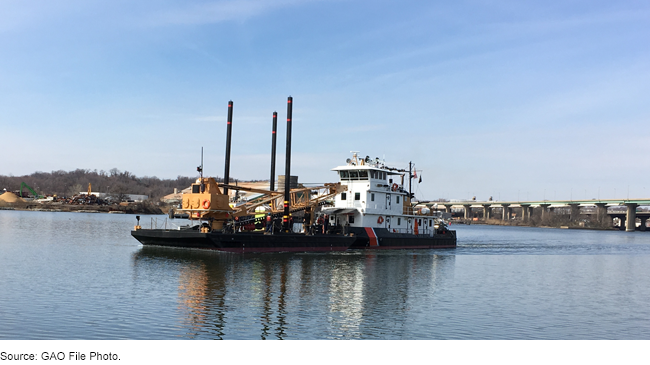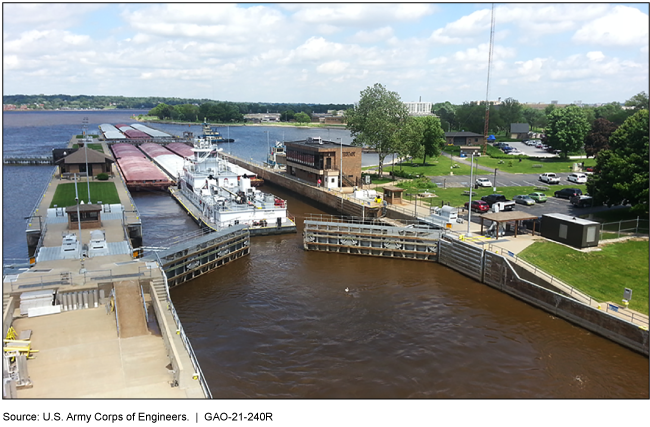U.S. Army Corps of Engineers: Information on the Navigation and Ecosystem Sustainability Program
Fast Facts
The Upper Mississippi river system provides about $1 billion in economic benefits annually through commercial boating and fishing. It's home to over 2.5 million acres of habitats, like wetlands, across 5 states.
The U.S. Army Corps of Engineers (Corps) is managing the Navigation and Ecosystem Sustainability Program, consisting of over 1,000 projects along the river to improve navigation delays and restore ecosystems damaged by humans. The program will cost about $7.9 billion over 50 years. Since 2004, the Corps has spent $65 million on technical studies and designs for 47 projects and hasn't secured partners needed to share costs.
Barges like this play a key role in helping keep navigation paths open on the Upper Mississippi River

Highlights
What GAO Found
The U.S. Army Corps of Engineers (Corps) has taken steps to implement its Navigation and Ecosystem Sustainability Program (NESP)—a dual-purpose program for navigation improvements and ecosystem restoration along the Upper Mississippi River system. Specifically, in 2004 the Corps identified 24 navigation improvement projects and 1,010 ecosystem restoration projects and proposed a plan for implementing them. For example, the Corps plans to construct or extend 12 locks to facilitate commercial barge traffic along the river system (see fig.), which the states of Illinois, Iowa, Minnesota, Missouri, and Wisconsin have generally relied on as their principal conduit for export-bound agricultural products. The Corps also plans to restore floodplains along the river system and backwaters that provide habitat for hundreds of species of wildlife. While the total estimated program cost is $7.9 billion, as of October 2020, the Corps has initiated technical studies and designs for 47 NESP projects at a cost of approximately $65 million.
Barge Tow at Lock and Dam 15 in Rock Island, Illinois

However, the Corps has identified several challenges facing the program, and it has taken steps to mitigate them. Specifically, the Corps was unable to implement NESP projects for 7 years because the program did not receive funding in fiscal years 2011 through 2017, in part because the Corps identified other projects as higher priorities. To mitigate this challenge, the Corps reprogrammed funding to help ensure projects could be executed when funds became available. Another challenge is that the Corps has not yet established partnership agreements that are needed for some NESP ecosystem projects. Corps officials said that about 15 to 20 percent of the ecosystem projects will require partnership agreements in which partners commit to share 35 percent of the project costs, typically through the purchase of land for the project. The officials said that partners may be reluctant to make financial commitments to projects while NESP funding is uncertain. Furthermore, the partnership agreements can take up to 18 months to put in place. To help expedite program implementation, Corps officials said they have pursued projects in fiscal year 2020 that can begin without a commitment from project partners.
Why GAO Did This Study
The Upper Mississippi River system provides approximately $1 billion in annual benefits to the nation’s economy through boating, fishing, and other uses, according to a Corps report. It also supports more than 2.5 million acres of aquatic, wetland, forest, grassland, and agricultural habitats. In 1986, Congress declared its intent to recognize the system as a nationally significant commercial navigation system and a nationally significant ecosystem. However, the Upper Mississippi River’s navigation system has faced significant delays in commercial boating and barge traffic, and human activity has caused a decline in environmental quality, according to a 2004 Corps report.
The Corps initiated studies in 1989 and 1990 to identify ways to improve the river system. The Corps issued a feasibility report in 2004 that identified improvement projects, and in 2007 Congress formally authorized NESP and the projects identified in the report.
GAO was asked to review NESP. This report describes (1) the steps the Corps has taken to implement NESP and (2) the challenges the Corps has identified to fully implementing the program and steps the Corps is taking to address these challenges. To conduct this work, GAO reviewed Corps reports, documents, and data from fiscal year 2005—the year in which the Corps began implementing NESP projects—through fiscal year 2020. GAO also interviewed Corps officials.
For more information, contact Mark Gaffigan at (202) 512-3841 or gaffiganm@gao.gov.
